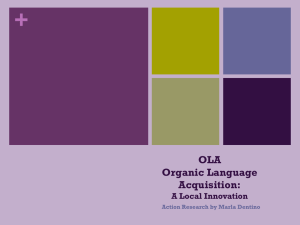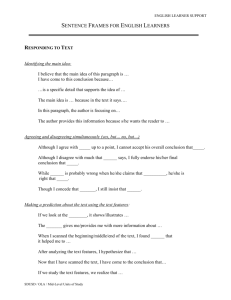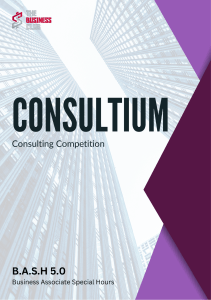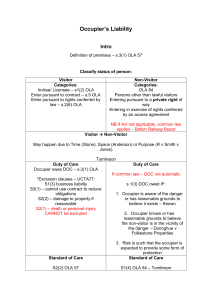Ola Electric Go-to-Market Strategy: EV Scooter Launch in India
advertisement
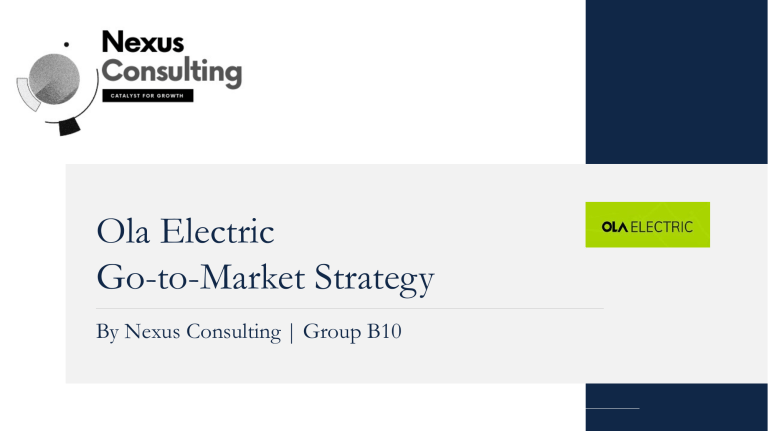
Ola Electric Go-to-Market Strategy By Nexus Consulting | Group B10 Problem Statement: Go-to-market Strategy for Ola Electric to sell 25,000 EV Scooters in India within 12 months of launch. 1. Industry Analysis 2. Competitor Analysis 3. Consumer Analysis 4. Target Market & Geography 5. Pricing & Competitive Positioning 6. User Journey 7. Marketing Strategy 8. Sales Strategy 2 1. Industry Analysis 2. Competitor Analysis 3. Consumer Analysis 4. Target Market & Geography 5. Pricing & Competitive Positioning 6. User Journey 7. Marketing Strategy 8. Sales Strategy 3 Between FY 2016-2020, the 2-wheeler EV sales in India grew by 66% CAGR. The country in FY2020 sold 152,000 EV units registering a 20% growth Y-O-Y. Industry Level Challenges o Higher dependence on import : primary components such as lithium battery, motor ,cobalt etc are imported. o Current competition with ICE-2W: Many industry leader in ICE-2W are waiting for right time to launch the EV-2W alternative of their product. o Lack of standardisation of hardware: Till now, there aren’t any industry or govt standards for hardware of charging EV-2W. Source: 2-Wheeler EV India Market Outlook by JMK Research & Analytics 4 Battery cost accounts to ~50% of the total EV cost. The industry is seeing decline in battery prices due to economies of scale with advancements in design and performance. Market Level Challenges • Fame-2 : Stringent criteria applicable for allowance of subsidies • High upfront costs: 60% costlier than 2W_ICE of similar specifications • High battery replacement cost: 40-45k after 4 years over normal wear and tear of vehicle • Low average: The EV-2W runs on average 75km-80km on single full charge of the battery whereas an ICE-2W runs around 300 km (assuming 5L tank capacity and average of 60km/L) • Lack of charging infrastructure: Till the end of 2019, India has only 1332 public charging stations. Space is the biggest constraint. • Low resale value, Low pickup and low top speed. Source: 2-Wheeler EV India Market Outlook by JMK Research & Analytics 5 SWOT Analysis – Ola Electric Strengths • • • • • • • • High Production Capacity Strategic Acquisitions & Partnerships Investments/Funding and unicorn status Self-owned Tech infrastructure Government Support Brand recognition Ability to pivot Hardware Software digital integration Opportunities • • • • • Growing EV market & Global expansion Government's Support in India Battery Swapping Ecosystem Fast-charging networks Make-in-India and Eco-friendly tag Source: The Ken, Ola’s path to 10 million EV Scooters Weaknesses • • • • • • • • New Entrant in the Market Affordability of the Product High Attrition in leadership Aggressive timelines Long approval timelines Lost talent from acquisition No battery swapping Constant changing decisions Threats • Competition from traditional two wheelers • Competition from already existing electric two-wheeler brands • Negative effects of the Covid pandemic • Poor infrastructure and unplanned cities in India • Price and Range anxiety 6 SWOT Analysis – Key Insights for Ola Electric STRENGTHS • High Production Capacity - World’s largest scooter manufacturing factory, annual production capacity - 10 million units • Strategic Acquisitions - Acquisition of Etergo BV, an electric scooter OEM, based out of Amsterdam • Strategic Partnerships - Tie up with ABB for robotics and automation solutions for the factory - Industry 4.0 principles • Investments/Funding - Raised about USD 400 million in funding from Tiger Global, Matrix India, Tata Sons Chairman etc. • Self-owned Tech infrastructure - Factory powered by Ola's own proprietary AI engine and Tech stack WEAKNESSES • New Entrant in the Market – Lack of relevant experience in the automobile industry • Affordability of the Product – At the proposed price of the product, cheaper options are available for the consumers • Aggressive timelines - The launch is happening within a year which may compromise on certain areas. • No battery swapping - No battery swapping facility being adopted currently which is the current way forward for the ecosystem to grow. OPPORTUNITIES • Growing EV market & Global expansion - India and international markets across Europe, the UK, Latin America, Australia, and New Zealand to play in • Government's Support in India - increased push for electric vehicles and home-grown technology in line with Prime Minister Narendra Modi’s Atmanirbhar Bharat vision THREATS • Competition from already existing electric two-wheeler brands – Ola Electric is a late entrant in this segment in India • Negative effects of the Covid pandemic and Poor infrastructure and unplanned cities in India. 7 1. Industry Analysis 2. Competitor Analysis 3. Consumer Analysis 4. Target Market & Geography 5. Pricing & Competitive Positioning 6. User Journey 7. Marketing Strategy 8. Sales Strategy 8 The Competitive Landscape in the 2-Wheeler EV India Market Source: 2-Wheeler EV India Market Outlook by JMK Research & Analytics 9 The competitive landscape is divided in terms of Battery and speed. More than 60% of the total 35 Models launched in the market are high speed electric scooters with Lithium-ion battery. • In terms of Battery, the Indian Electric Wheeler Market is divided into two segments i.e., Lead based Battery and Lithium-ion Battery. Lithium-ion Battery has the greatest market share as they are light weighted, thermally stable and supports fast charging. In term of battery life also lithium-Ion batteries can last long for 10 years. MARKET SHARE-HIGH SPEED AMPERE 10% ATHER ENERGY 12% HERO ELECTRIC 31% Source: Bikewale.com OTHERS 5% OKINAWA 42% • In terms of speed, The India Electric 2-wheeler market is divided into two segments. I.e., High speed Electric 2wheeler market and low speed electric 2-wheeler market. High speed Electric 2 wheelers are those whose speed is greater the 25 KMPH and Low speed Electric 2 wheelers are those whose speed is less than 25KMPH. Majority of the Indian Electric 2-wheeler Market is tilted towards High-speed electric wheelers whose market share is around 65%. 10 Distribution Network: Ola Electric should follow Ather Energy’s strategy for the initial launch with focused presence in few cities and drive sales volume. Operating States Count No. of Dealers/Experience Stores 700 30 600 600 25 500 350 400 350 300 26 25 20 13 15 10 200 100 7 5 11 0 0 Hero electric Okinawa Ather Ampere Hero electric Okinawa Ather Ampere Sales Volume 60000 50000 50000 40000 40000 30000 30000 20000 20000 • Even though Ather operates in very few states with limited number of dealer/experience stores, the sales volume is good. 10000 0 Hero electric Okinawa Ather Source: Official Company Website, Bikewale, Zigwheels Ampere 11 Key advantages of Ola Electric over its competitors 1. Closest player: OLA Electric scooter are the first in the electric 2-wheeler segments whose max speed is 100 KMPH. Ather energy who is the OLA’s closest competitor can provide the max speed of 80 KMPH. 2. Storage Space: In terms of storage space, OLA has managed to provide the space of 50 Litres while its competitors are able to provide the storage space ranging from 10 Litres – 25 Litres. 3. Battery: OLA Electric scooter comes with the 1.2KW ×3 swappable batteries which provides him the competitiveness in terms of efficiency among his competitors. 4. Features: In term of features such as Touch screen display, GPS and mobile connectivity, the only competitors for OLA are Ather energy. Ather Energy has two models in the market which have the same features as the OLA electric Scooter. 5. Charging Time: Charging time of 1-2 hours is something which is incredibly unique for OLA, as no competitors in the market offers such a low charging time. As per the market reports OLA Scooter can charge up to 50% is 18 Minutes which can provide the back up for travelling up to 75 Kms, provided rider maintains the low speed while riding. 12 1. Industry Analysis 2. Competitor Analysis 3. Consumer Analysis 4. Target Market & Geography 5. Pricing & Competitive Positioning 6. User Journey 7. Marketing Strategy 8. Sales Strategy 13 Consumer Survey: Key Insights on Popularity, Consumption, and Brand Awareness 1. POPULARITY -Among 141 responses, 77.3% of the people responded that they own a bike/scooty/Scooter(petrol) and 40.4% of people use the two-wheeler on daily basis. 2. CONSUMPTION- On an average, respondent spent the Rs.2000 monthly on fuel on a two-wheeler. 3. BRAND AWARENESS - Among respondents , Hero Electric had the highest brand awareness, followed by the OLA Electric and Ather Energy. . Source: Consumer survey, N=141 responses 14 Consumer Survey: Key Insights on features in an EV scooter 4. FEATURES MATTERS THE MOST - Respondents rated the “Distance covered in the single charge” as the most important factors in an Electric 2-Wheeler Scooter. The Other important factors were Aesthetics, Comfort, distance and Self-diagnosis. 5. FEATURES DOES NOT MATTER - Respondents does not seemed to be too optimistic regarding features such as Touch Screen, GPS and mobile App connectivity. Source: Consumer survey, N=141 responses 15 Consumer Survey: Key Insights on purchase decisions and buying process 5. BARRIERS IN MAKING PURCHASE DECISIONAvailability of charging station is one of the factors which acts as a barrier in purchase of the Electric 2-Wheeler. Other factors such as Availability of service centres and the Battery range are also the factors which acts as a barrier in purchase of Electric 2-Wheeler Scooter. 6. BUYING PROCESS - Respondents prefer to take test rides at the showroom before making the decision to purchase an Electric 2-Wheeler. Apart from the test ride respondents do conduct the research on automobile platforms such as bikewale.com and on you tube before making their purchase decision. Source: Consumer survey, N=141 responses 16 For the past 12 months, the popularity index for Electric Scooter has been higher than Electric Bikes as per the Google Trends Analysis. Top 5 Cities (Last 12 months) Popularity Index Electric Scooters Electric Bikes Bangalore Surat Thiruvananthapuram Pimpri-Chinchwad Navi Mumbai Chennai Mysore Coimbatore Kochi Secunderabad • The average popularity score for Electric Scooter is 39 vs. Electric Bike is 35. • There was a surge in popularity during Jan-Mar 2021 period when India witnessed an ease in lockdown restrictions and economic recovery. Source: Google Trends Analysis as of 31st May 2021 17 For the past 12 months, the popularity index for the Hero Electric Brand is 10X more than Ola Electric and Ather Energy as per Google Trends Analysis. Top 5 Subregions (Last 1 year) Popularity Index Ola Electric Hero Electric Ather Energy Pondicherry Orissa Karnataka Tamil Nadu Haryana Tamil Nadu Karnataka Pondicherry Andhra Pradesh Goa West Bengal Delhi Maharashtra Tamil Nadu Kerala • During Jan-Mar 2021 period, when the Indian economy was showing signs of recovery due to easing of restrictions, Hero Electric and Ola Electric showed a huge spike in demand. However, the same wasn’t reflected for Ather Energy. Source: Google Trends Analysis as of 31st May 2021 18 Key insights based on the 22 in-depth one-on-one consumer interviews conducted with consumers between the age group of 25-60 from different backgrounds and cities. 1 Charging Infrastructure The charging infrastructure remains a key hurdle in the minds of the consumers to switch to a 2-wheeler EV. Consumers’ confidence will rise as the charging infrastructure development is highlighted. 4 Usage The primary usage of the 2-wheeler EV will be for commute, daily chores within range of 20 kms maximum. Consumers don’t mind switching having an EV as a secondary means of personal transport for this usage. Source: 22 one-on-one Consumer Interviews 2 Range Anxiety Consumers feel 2-wheeler EVs can only be used for shorter rides and are highly concerned about the range provided by the batteries of these EVs in a single charge. 5 Pricing Consumers are willing to pay above Rs.75,000 for a good quality EV provided it meets all their requirements. Only some are willing to pay in the range of Rs.1.2-1.5 lakhs for an EV. 3 Safety Consumers are concerned about the durability and the safety aspects of the 2-wheeler EV in comparison to petrol-fueled bikes and scooters. 6 Brand Perception Consumers don’t mind opting for a better-quality EV product from a new player compared to an average quality product by an established player in the market. EV technology is quite new and hence, the old players do not necessarily have an edge. 19 1. Industry Analysis 2. Competitor Analysis 3. Consumer Analysis 4. Target Market & Geography 5. Pricing & Competitive Positioning 6. User Journey 7. Marketing Strategy 8. Sales Strategy 20 Target Market: We recommend that Ola Electric targets consumers aged 25-40 with mid to high income range for its go-to-market plan. Why this target market? Target Consumer • • • • Age Range: 25-40 Income Class: Mid to High Income Geography: Tier 1 /Metropolitan Background: Working Professionals Source: Consumer Survey Analysis Based on the survey/interviews/discussions with Industry experts, this segment: • Understands the EV segment and developments happening in this sphere • Willingness to try newer products • Digitally equipped • Ready to spend if value proposition expected is offered: performance, aesthetics, battery life • Daily usage for office commute • Easy to target through Digital Media channels • First automobile buy is normally a two-wheeler • Parent Brand Awareness index high – 97% users were aware of OLA 21 Target Geography: We recommend that Ola Electric starts with Tier 1 cities for its go-tomarket plan. Why this target geography? Based on Target Group identified, • These cities have the higher density of TG • Demand Availability and growth • Growth rate of city • Last Mile Support • Awareness • Charging Network viability • Interest of people As per Google Trends Analysis, Bangalore and Chennai come in the top 3 cities for the popularity index for the last 12 months for Electric Scooters and Electric Bikes. Karnataka and Tamil Nadu have delivered the highest volume of sales in EVs for the last 3 years. Karnataka is also the fastest growing market for EV in India. Source: Google Trends Analysis as of 31st May 2021 and JMK Report on EV Outlook India 22 1. Industry Analysis 2. Competitor Analysis 3. Consumer Analysis 4. Target Market & Geography 5. Pricing & Competitive Positioning 6. User Journey 7. Marketing Strategy 8. Sales Strategy 23 Pricing: We recommend that Ola Electric price its EV Scooter in the range of Rs.95,000 – Rs.1,10,000 for its base model*. Ola Electric Value Proposition: Sustainable and safe mobility for everyone. • Based on the feedback from interviews/surveys, we saw that Ola Electric has a higher degree of differentiation on performance, fast charging and aesthetics compared to other players in the market. • Also based on the analysis of survey results, we saw that consumers gave high importance for performance and comfort. • We requested the consumers to quote a price, based on the value offered and we got the price around Rs 95000. • In terms of features and performance, main competitor for OLA is Ather energy and they have priced similar products for Rs.1.2 Lakhs – Rs.1.5 Lakhs. • Summing it up all, we suggest Ola Electric to price anywhere around Rs.95,000 to Rs.1,10,000 Note: This pricing doesn’t include the subsidy applicable under the FAME-II scheme. Source: Consumer Research Analysis, Bikewale.com 24 Competitive Positioning: Price vs. Range PRICE VS RANGE In terms of competitive positioning of Range Vs Price, Hero Electric has edge over Ola electric and other competitors. RANGE Currently Hero Electric is offering the Electric scooter at a price point of Rs.82,903 with a range of 108 km/Charge while Ola electric scooter is positioned to offer 100Km/charge at a price point of around Rs.1,00,000. PRICE Source: BikeWale, Ola Electric specifications and prices are speculative. 25 Competitive Positioning: Price vs. Performance PRICE VS PERFROMANCE In terms of competitive positioning of Performance Vs Price, Ola Electric has the competitive advantage over other players PERFROMANCE Currently Ola Electric is offering the Electric scooter with a top speed of 100 Km/hr while Other competitors are only able to give the Top speed of 80Km/hr. Ola Electric needs to use the performance as one of the key points while positioning its scooter to the customers. PRICE Source: BikeWale, Ola Electric specifications and prices are speculative. 26 Competitive Positioning: Price vs. Aesthetics / Features AESTHETICS/FEATURES PRICE VS AESTHETICS In terms of competitive positioning of Price Vs Aesthetic , Ola Electric has the competitive advantage over other players Currently Ola Electric is offering the great aesthetics and features such as Bluetooth Calling, GPS and Self Diagnosis at a price point of Rs.1,00,000. Same features are also offered by the Ather Energy but at a higher price point of Rs. 1.2-1.5 Lacs. Since there is only one competitor which is Ather energy providing the latest features, Ola Electric needs to use the Aesthetics and features as the key points while positioning its scooter to the customers. PRICE Source: BikeWale, Ola Electric specifications and prices are speculative. 27 Differentiation: We recommend that Ola Electric focuses on specifications such as motor power, battery capacity, charging time, top speed for its communication strategy. HERO ELECTRIC SPECIFICATIONS PHOTON HX OKINAWA OPTIMA HX(DUAL BATTERY) ATHER ENERGY PRAISE PRO ATHER 450 Plus OLA ELECTRIC ATHER 450 X OLA ELECTRIC MOTOR POWER 1200-1800 W BLDC 550 W-1200 W BLDC 1000 W -2500 W BLDC 5400 W PMSM 6 KW PMSM 6KW, Brushless DC Motor RANGE 108 KM/ CHARGE 122KM/CHARGE 88KM/CHARGE 100 KM/CHARGE 116 KM/ CHARGE 100KM/CHARGE SPEEDOMETER DIGITAL DIGITAL DIGITAL Touch Screen Oddometere, Android OS Touch Screen Oddometere, Android OS Digital Display, Touch Screen BATTERY CAPACITY 72V 26 AH 51.2 V 30Ah × 2 72 V 2Kw 2.9Kwh 2.9 Kwh 1.5 KW×3, Swappale Battery BATTERY TYPE Li-ion Li-Ion Li-ion Li-ion Li-ion Li-ion BREAK TYPE DRUM DRUM DISC BREAK - BOTH SIDE DISC BREAK - BOTH SIDE DISC BREAK - BOTH SIDE DUAL DISC BREAK CHARGING TIME 8-10 Hours 4-5 HRS 2-3 HOURS 5-6 HOURS (Waterproof Battery) 5-6 HOURS (Waterproof Battery) 1-2 HOURS KERB WEIGHT 116Kg 83 KG 150KG 108 KG 108 KG 74KG ABS NO NO E-ABS No No No LOAD BEARING CAPACITY 130-150 (2 Adults) 130-150 (2 Adults) 150KG 150-200 150-200 150KG MOBILE APP CONNECTIVITY NO NO NO YES YES ( Calling Feature, Bluetooth) Yes GPS NO NO NO YES YES Yes TOP SPEED 45KMPH 42KMPH 58KMPH 80KMPH 80KMPH 100KMPH WARRANTY 3 Years 3 Years 3 Years 3 Years 3 Years 3 YEARS PRICE ₹ 82,903.00 ₹ 78,640.00 ₹ 79,277.00 1.27 LAKHS 1.47 LAKHS ₹ 1,00,000.00 *POP refers to Points of Parity, POD refers to Points of Differentiation Source: BikeWale, BikeDekho, Official Websites of players POD* POP* 28 1. Industry Analysis 2. Competitor Analysis 3. Consumer Analysis 4. Target Market & Geography 5. Pricing & Competitive Positioning 6. User Journey 7. Marketing Strategy 8. Sales Strategy 29 Customer Journey: Ola Electric will sell its Electric Scooters through online platform through their websites only* (later through app as well). Book a Test Ride Visit the Ola Electric Website 3 4 Visit the Experience Centre 1 Register using your email address 2 *The scope of the GTM has been identified through primary research from an Ola Electric Executive. 5 Purchase Ola Electric Scooter 30 PROCESS AWARENESS CONSIDERATION PURCHASE • USER ACTIONS TOUCH POINTS • • Become aware about Ola Electric Visit the website Register • • • • • • • Digital Ads Bike Review Platforms Press Release Influencers Youtube Channels Ola Cabs App Word of Mouth • • • • • • • • • • • POSSIBLE PAIN POINTS • • Information on the website is not enough The resistance to register using email ID • • • Book a test ride Visit the Experience Center Interaction with Product Specialist Perform the Test Ride • • • • Remarketing Ads Email Marketing Digital Ads – Book your test ride Experience Center Visit Interaction with Product Specialist • Too many steps to book a test ride Availability of dates & times Experience Centre not close enough Product Specialist interaction not meaningful • • • • • • • Visit the Website or log-in to the app Choose the desired model / variant Select payment mode Select Delivery Option Make the purchase Ola Electric Website/App Finance Partners Modes of Payment Pick up from the Center or Delivery of the Scooter Model / Variant not available Waiting time or delivery time too high Payment mode not available Ease of financing ADVOCACY • • • • • • • • • • • Share experience or review on Social Media Word of Mouth promotion Referral Incentives Engages with CRM Manager Customer Testimonials Customer Relationship Manager Referral Campaign Ola Electric EV Rider Community Not too keen on sharing experiences with their network Reputation shouldn’t get hampered CRM Manager is not responsive or supportive 31 1. Industry Analysis 2. Competitor Analysis 3. Consumer Analysis 4. Target Market & Geography 5. Pricing & Competitive Positioning 6. User Journey 7. Marketing Strategy 8. Sales Strategy 32 The Marketing Strategy must focus on removing the functional barriers (usage, value, and risk) and the psychological barriers (tradition and image) to drive adoption. Performance Marketing Growth through Referral • • • • • • • • Search Engine Marketing Google AdWords Display & Discovery Ads Facebook Ads, Instagram Ads Influencers Referral Campaign Referral Incentives & Add-ons Customer Testimonials Organic Marketing Ola EV Community • • • • • • Search Engine Optimization Content Marketing Podcast and blogs YouTube Channel Social Media Engagement • • Added benefits with other service providers – ranging from food delivery, e-commerce, OTT Build a network of like-minded people Foster brand loyalty and retention 33 Sales Strategy: A high quality product specialists' team combined with a superior experience delivered to early-adopters through customer support will fuel the sales engine. 1 CRM System Implement a strong CRM system to personalize the user journey (from website to purchase) and assist the user at different stages in the sales journey. 4 Ownership Models Explore different ownership models such as long-rentals and exchange offers in addition to direct purchase to make adoption easier for the target market. Source: Industry Experts Insights 2 Experience Centers Launch Experience Centers in prime locations in Tier 1 cities to educate customers about EVs and provide an in-depth experience about riding and owning an Ola Electric EV. 5 Customer Support Assign dedicated Customer Relationship Managers to deliver a superior after-sales experience as they can create advocacy for Ola Electric brand and drive revenue growth in the long-term. 3 Product Specialists Product Specialists understand the EV technology in-depth and are responsible to educate the customers in the simplest way. Focus on hiring, training, and their performance by setting the right KRAs to grow sales. 6 Early-adopters Focus on the experience of earlyadopters to ensure high satisfaction. Building a strong community of early-adopters can be instrumental in shaping up the growth trajectory, and drive word of mouth marketing. 34 Go-to-Market Plan Success Metrics • Ola Electric captures 10% of the market share of 2-wheeler EV sales in India within 12 months of launch. • Ola Electric at the end of 12 months is able to drive the sales at positive unit economics. 35 Thank You Nexus Consulting
